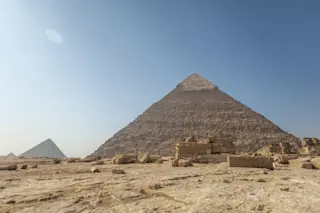The Egyptian pyramids are considered one of the Seven Wonders of the World, and it’s not surprising: when you stare at the massive structures, you can’t help but wonder, “How the hell did they do it?” The stones, some weighing 9,000 pounds, came from far away and needed to be dragged into place. Now, researchers from the University of Amsterdam believe they’ve discovered ancient Egyptians’ cunning strategy to move those massive stones: wet sand.
With the right amount of water, researchers found, sand turns into a sturdy surface that halves the force needed to drag sleds loaded with rocks or statues across the desert. In fact, an ancient wall painting in the tomb of Djehutihotep shows a person pouring water over the sand in front of a sledge.
Sand builds up in front of the sledge when it is dragged over dry sand. On the wet, compact sand this does ...














